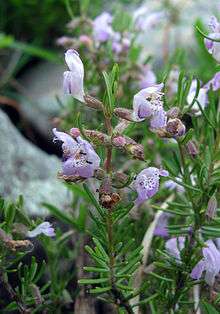Conradina verticillata
| Conradina verticillata | |
|---|---|
 | |
| Wild specimen on the Big South Fork of the Cumberland River | |
| Scientific classification | |
| Kingdom: | Plantae |
| (unranked): | Angiosperms |
| (unranked): | Eudicots |
| (unranked): | Asterids |
| Order: | Lamiales |
| Family: | Lamiaceae |
| Genus: | Conradina |
| Species: | C. verticillata |
| Binomial name | |
| Conradina verticillata Jennison | |
Conradina verticillata is a species of flowering plant in the mint family known by the common names Cumberland rosemary, or Cumberland false rosemary, and upland rabbitbane. It is endemic to the Cumberland Plateau in the United States, where it occurs along the tributaries of the Cumberland River and the Tennessee River in Kentucky and Tennessee. It is known from several occurrences (48 in 1991[1] and 91 by 1996[2]) which are mostly small and often degraded in quality. Because many occurrences of the plant are threatened by numerous processes, the plant is federally listed as threatened.[3]
The plant grows next to streams and on islands in flood plains. The plant grows in higher areas that keep it out of the harshest flooding. The substrate is sand or rocks. The main threat to the species is degradation of this type of habitat by recreational activity such as hiking and white-water rafting, construction of dams, coal mining waste and other pollution, and other processes.[1][2] It can be found alongside other rare plants such as Monongahela Barbara's buttons (Marshallia grandiflora) and Virginia meadowsweet (Spiraea virginiana).[2]
In general, the plant resembles rosemary.[1][2] It is a relatively small shrub not exceeding half a meter tall in the wild. The stems spread along the ground, rooting at nodes that come in contact with moist substrate. The plant forms clumps or low mats. The stems are lined with clusters of linear, needlelike leaves up to 2.5 centimeters long. The herbage is aromatic, the scent similar to rosemary. The double-lipped flowers are 2 centimeters long or more and generally purple in color with red spotting on the lower lip. White flowers occur occasionally.[1][2]
This now-rare plant is thought to be a relict of a much more common species that was able to survive only on floodplains as the Cumberland Plateau formed.[2][3] It is also separated from the other members of genus Conradina geographically and ecologically, and it has three sets of chromosomes in its cells (triploid) while all the others have two sets (diploid).[3]
This shrub is not difficult to cultivate and it is grown as a garden plant. Some cultivars are available, such as the white-flowered 'Snowflake'.[4]
References
- 1 2 3 4 Conradina verticillata. Center for Plant Conservation.
- 1 2 3 4 5 6 Conradina verticillata. The Nature Conservancy.
- 1 2 3 USFWS. Conradina verticillata (Cumberland Rosemary) determined to be threatened. Federal Register November 29, 1991.
- ↑ Conradina verticillata. North Carolina State Plant Fact Sheets.
